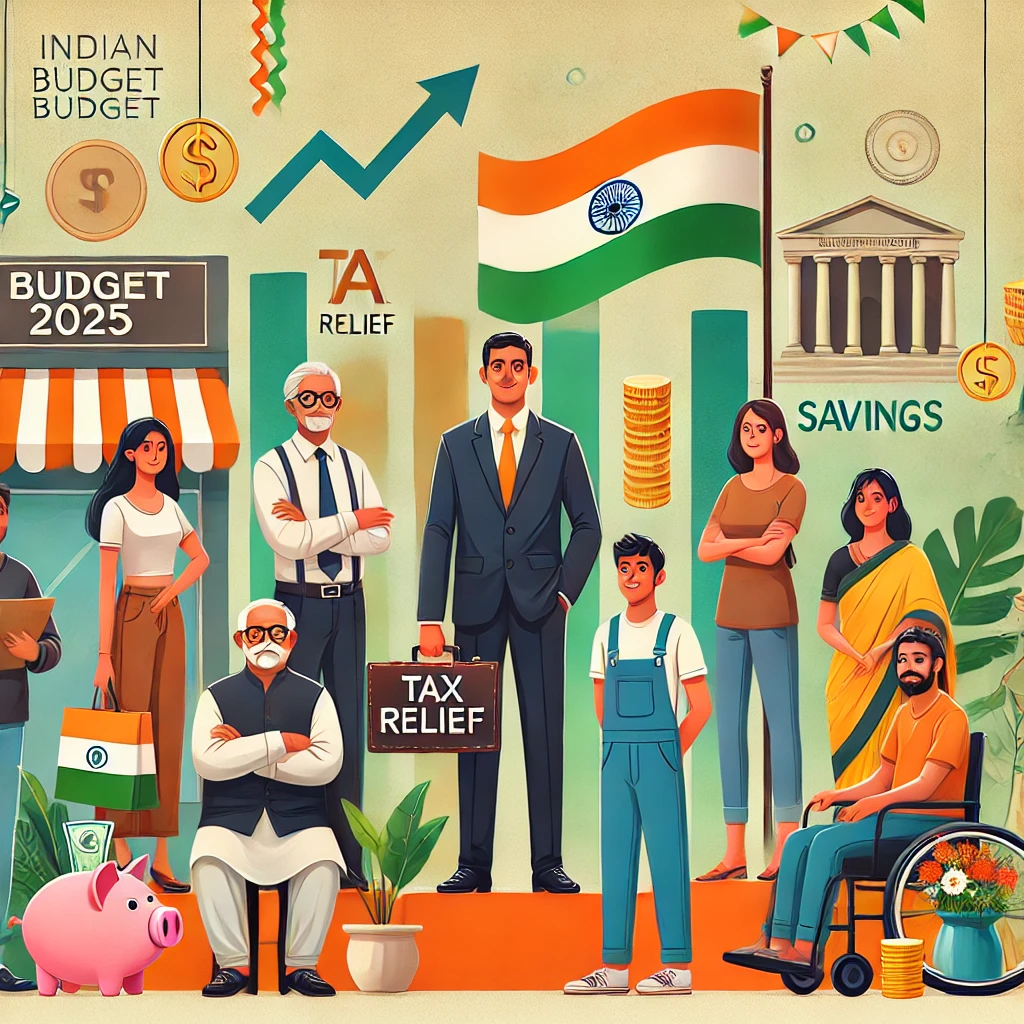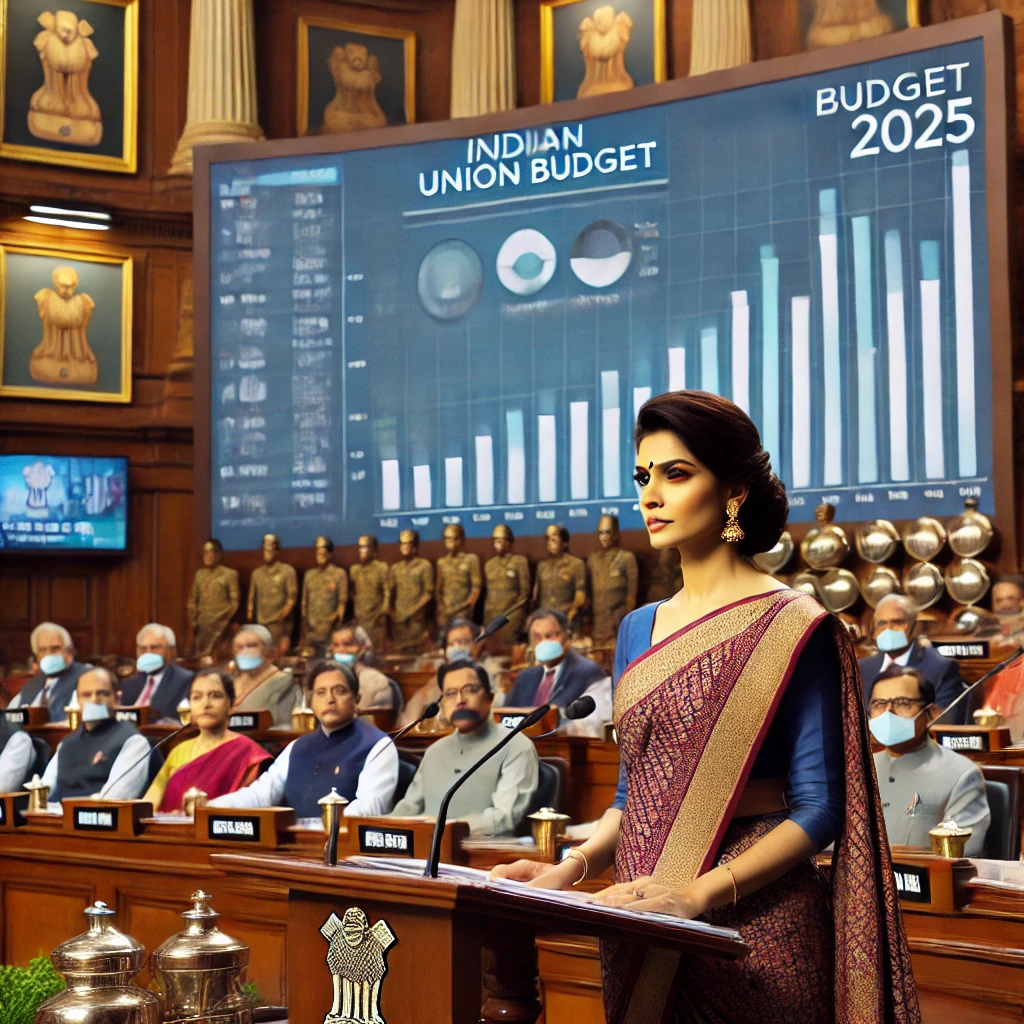Middle class has been critical of the last years budget. But this year it is a different story altogether. The Union budget decides the financial fate of the nation and also its 150 crore people directly as well as indirectly. Union Finance Minister Nirmala Sitharaman presented the Union Budget 2025-26 today, focusing on several key areas to drive transformative reforms and inclusive growth. Here are some of the major highlights
Table of Contents
Benefits for the Middle Class.
Implications for the Indian Economy.
Summarizing the impact on prices of consumer goods like food items and electronics.
Top 10 Key Features of the Budget
Challenges and Considerations:
Measures to Achieve the Projected Growth:
Conclusion – A Balanced and Growth-Oriented Budget
Key Focus Areas
- Agriculture: Introduction of the Prime Minister Dhan-Dhaanya Krishi Yojana to enhance agricultural productivity and support farmers.
- Rural Prosperity: Launching a comprehensive program to address under-employment in agriculture and invigorate the rural economy.
- MSMEs: Enhancing credit guarantee cover limits for MSMEs, doubling the cover for micro enterprises from ₹5 crore to ₹10 crore.
- Tax Reforms: Initiatives to simplify the tax system and provide incentives for investment and innovation.
- Employment: Measures to stimulate employment and support the rising middle class.
- Energy: Securing energy supplies and promoting sustainable practices.
- Exports: Promoting exports to boost India’s global positioning.
- Innovation: Nurturing innovation across various sectors.

Vision for Viksit Bharat
The budget aims to achieve a Viksit Bharat (Developed India) by focusing on zero poverty, quality education, comprehensive healthcare, skilled labor, women’s economic participation, and making India the food basket of the world.
the details of the new tax slabs introduced in the Union Budget 2025 and their benefits for the middle class:
New Tax Slabs (New Tax Regime)
- Income up to ₹4 lakh: 0% tax
- Income from ₹4 lakh to ₹8 lakh: 5% tax
- Income from ₹8 lakh to ₹12 lakh: 10% tax
- Income from ₹12 lakh to ₹16 lakh: 15% tax
- Income from ₹16 lakh to ₹20 lakh: 20% tax
- Income from ₹20 lakh to ₹24 lakh: 25% tax
- Income above ₹24 lakh: 30% tax
Benefits for the Middle Class
- No Tax for Income up to ₹12 lakh: One of the most significant changes is that individuals with an annual income up to ₹12 lakh will not have to pay any income tax. This is a substantial relief for the middle class, as it effectively increases their disposable income1.
- Lower Tax Rates: The new tax slabs offer lower tax rates compared to the previous regime, which means that even those earning above ₹12 lakh will benefit from reduced tax rates.
- Simplified Tax System: The new tax regime offers a simplified tax structure with lower rates but without exemptions. This makes it easier for taxpayers to understand and comply with their tax obligations1.
- Increased Standard Deduction: The standard deduction has been increased from ₹50,000 to ₹75,000 under the new tax regime, providing additional relief to salaried individuals.
- Tax Rebate: A tax rebate is provided to ensure that individuals with an income up to ₹12 lakh do not have to pay any tax, even after considering the standard deduction.
These changes are aimed at providing significant relief to the middle class, boosting their purchasing power, and promoting economic growth.
The Indian Union Budget for 2025, presented by Finance Minister Nirmala Sitharaman on February 1, 2025, introduces a series of strategic initiatives aimed at bolstering economic growth, providing relief to the middle class, and fostering sustainable development. This comprehensive analysis delves into the budget’s salient features, its anticipated impact on the middle class, and its broader implications for the Indian economy.
Salient Features of the Indian Union Budget 2025
- Personal Income Tax Reforms: In a significant move to enhance disposable income, the budget proposes a reduction in personal income tax rates and raises the non-taxable income threshold to ₹1.28 million. This initiative is expected to cost the exchequer approximately ₹1 trillion in tax revenues but aims to stimulate consumer spending.
- Fiscal Deficit Targeting: The government sets an ambitious target to reduce the fiscal deficit to 4.4% of GDP, reflecting a commitment to fiscal prudence while balancing growth objectives.
- Capital Expenditure Enhancement: A moderate increase in capital spending is outlined, focusing on infrastructure projects to stimulate private investment and address concerns of slowing growth.
- Agricultural Support Initiatives: The budget introduces enhanced support for farmers, including increased allocations for agricultural development programs, aiming to boost productivity and rural incomes.
- Sectoral Reforms: Key sectors such as agriculture, manufacturing, and financial services receive targeted reforms, including an increase in the Foreign Direct Investment (FDI) limit in the insurance sector to 100%, to attract investment and drive growth.
- Inclusive Development Programs: The budget emphasizes inclusive development with programs targeting youth, women, and underprivileged communities, aiming to promote equitable growth.
- Infrastructure Development: Significant allocations are made for infrastructure development, including transportation and urban development projects, to improve connectivity and support economic activities.
- Digital Economy Initiatives: The budget proposes measures to promote the digital economy, including investments in digital infrastructure and initiatives to enhance digital literacy.
- Healthcare and Education Funding: Increased funding is allocated to healthcare and education sectors to improve public services and human capital development.
- Environmental Sustainability Measures: The budget includes measures to promote environmental sustainability, such as investments in renewable energy and initiatives to combat climate change.
Impact on the Middle Class
The reduction in personal income tax rates and the increase in the non-taxable income threshold are poised to directly benefit the middle class by increasing disposable income. This boost in spending power is anticipated to enhance consumer demand, thereby stimulating economic activity. Additionally, increased allocations for healthcare, education, and infrastructure development are expected to improve the quality of life for middle-class families by providing better services and opportunities.

Implications for the Indian Economy
The budget’s focus on fiscal consolidation, infrastructure development, and sectoral reforms is designed to foster a conducive environment for sustainable economic growth. The targeted reduction in the fiscal deficit demonstrates a commitment to fiscal discipline, which is crucial for macroeconomic stability. Enhanced capital expenditure is expected to crowd in private investment, addressing concerns of slowing growth and high inflation. Moreover, reforms in key sectors and initiatives to promote inclusive development are likely to contribute to a more balanced and resilient economy.
Summarizing the impact on prices of consumer goods like food items and electronics
The Union Budget 2025 has several implications for consumer goods prices, particularly for electronics and food items. Here’s a summary of the expected impact:
Electronics
- Reduction in Customs Duty: The budget proposes a reduction in customs duty on certain electronic components, which is expected to lower the prices of electronic goods. This includes items like mobile phones, laptops, and other consumer electronics1.
- Increased Production: Lower import duties and incentives for domestic manufacturing are likely to boost production, leading to more competitive prices for consumers.
- Tax Incentives: Tax incentives for companies investing in electronic manufacturing are expected to further reduce costs, benefiting consumers.
Food Items
- Exemption from Customs Duty: Certain food items, especially raw materials for food production, have been exempted from customs duty, which should help in reducing the overall cost of food products.
- Support for Agriculture: Initiatives like the Prime Minister Dhan-Dhaanya Krishi Yojana aim to enhance agricultural productivity, which could stabilize food prices and make them more affordable.
- Subsidies: Continued subsidies on essential food items will help in keeping prices in check for the general public.
Overall, the budget aims to make essential goods more affordable while promoting domestic manufacturing and reducing dependency on imports. This should positively impact consumer prices, making electronics and food items more accessible to the general public.
Top 10 Key Features of the Budget
- Personal Income Tax Reduction: Lowered tax rates and increased non-taxable income threshold to ₹1.28 million.
- Fiscal Deficit Reduction: Set a target to reduce the fiscal deficit to 4.4% of GDP.
- Capital Expenditure Increase: Enhanced spending on infrastructure projects to stimulate growth.
- Agricultural Support: Increased allocations for farmer support and agricultural development programs.
- FDI Limit in Insurance: Raised the Foreign Direct Investment limit in the insurance sector to 100%.
- Inclusive Development Programs: Launched initiatives targeting youth, women, and underprivileged communities.
- Infrastructure Development: Significant allocations for transportation and urban development projects.
- Digital Economy Promotion: Investments in digital infrastructure and literacy initiatives.
- Healthcare and Education Funding: Increased funding for public services in healthcare and education.
- Environmental Sustainability Measures: Investments in renewable energy and climate change initiatives.

Growth Rates Projected
The Indian government projects a GDP growth rate of 6.3% to 6.8% for the fiscal year 2025-26. This projection is based on several factors and initiatives aimed at sustaining economic growth and stability1.
Factors Contributing to the Projected Growth Rate:
- Robust Domestic Economy: The fundamentals of the domestic economy remain strong, with a solid external account, calibrated fiscal consolidation, and stable private consumption.
- Government Initiatives: Various government schemes and initiatives, such as the PM GatiShakti National Master Plan and Startup India, are expected to drive growth by enhancing infrastructure and fostering innovation.
- International Projections: The projection aligns with forecasts from international agencies like the International Monetary Fund (IMF), Asian Development Bank (ADB), and World Bank, which also predict a growth rate of around 6.5% for FY26.
- Economic Survey: The Economic Survey 2024-25, presented by Finance Minister Nirmala Sitharaman, highlights the expected growth rate and factors contributing to it.
Challenges and Considerations:
- Slower Growth in Manufacturing: There has been a slowdown in manufacturing activity, which has impacted the overall growth rate.
- Government Spending: Reduced government expenditure has also been a factor in the slower growth projection.
- Inflation: Persistent inflation above the Reserve Bank of India’s (RBI) medium-term target of 4% has been a challenge.
Measures to Achieve the Projected Growth:
- Infrastructure Development: Continued investment in infrastructure projects under the PM GatiShakti National Master Plan to boost economic activity.
- Support for MSMEs: Enhancing credit guarantee cover limits for MSMEs to promote entrepreneurship and job creation.
- Innovation and Technology: Fostering innovation through initiatives like Startup India to drive technological advancements and economic growth.
- Sustainable Practices: Promoting sustainable practices to ensure long-term economic stability and growth.
The government’s focus on these areas is expected to help achieve the projected growth rate and support the vision of a Viksit Bharat
Top 25 Frequently Asked Questions (FAQs) on the Indian Union Budget 2025
- What are the new personal income tax rates?
The budget proposes a reduction in personal income tax rates and raises the non-taxable income threshold to ₹1.28 million. - How will the tax changes affect the middle class?
The reduction in tax rates and increased non-taxable income threshold are expected to increase disposable income for the middle class, enhancing their spending power. - What is the fiscal deficit target for 2025-26?
The government aims to reduce the fiscal deficit to 4.4% of GDP. - How much has capital expenditure increased?
The budget outlines a moderate increase in capital spending, focusing on infrastructure projects to stimulate private investment. - What support is provided for farmers?
The budget increases allocations for agricultural development programs, enhances crop insurance coverage, and introduces incentives for sustainable farming practices. - Has the GST rate changed for any sectors?
No major changes in GST rates have been announced, but the government has introduced measures to simplify GST compliance for small businesses. - What are the key provisions for small businesses and startups?
The budget provides tax incentives, easier access to credit, and digital infrastructure support to boost the startup ecosystem and MSMEs. - How will this budget impact economic growth?
By boosting capital expenditure, supporting key sectors, and reducing fiscal deficit, the budget aims to sustain India’s economic growth at around 7% in the coming fiscal year. - Are there any changes in corporate tax rates?
No major changes in corporate tax rates have been introduced, but certain sectors like manufacturing and infrastructure receive targeted tax benefits. - What are the major infrastructure projects announced?
The budget includes significant allocations for roadways, railways, urban development, and smart city initiatives to enhance connectivity and economic productivity. - How does the budget support the ‘Make in India’ initiative?
The government has introduced incentives for domestic manufacturing, increased import duties on certain foreign goods, and provided subsidies for indigenous industries. - What measures have been taken to tackle inflation?
The budget focuses on increasing supply-side measures, including boosting agricultural production and ensuring stable energy prices, to control inflationary pressures. - Is there any relief for senior citizens in this budget?
Yes, the exemption limit for senior citizens has been raised, and additional healthcare benefits have been provided under government schemes. - What initiatives are there for women entrepreneurs?
Special credit schemes, lower interest loans, and training programs have been introduced to empower women-led businesses. - How does the budget address employment generation?
The government has introduced incentives for job creation in the manufacturing, digital, and tourism sectors and expanded skilling programs for youth. - What are the new initiatives for the healthcare sector?
The budget increases funding for public hospitals, boosts medical research, and introduces tax benefits for health insurance and preventive care. - Has there been any increase in education sector spending?
Yes, the budget provides more funds for digital education, scholarships, and vocational training programs to bridge skill gaps. - What new schemes have been announced for rural development?
Increased funding for rural employment schemes, better access to clean water and sanitation, and rural digital connectivity programs have been introduced. - How does the budget promote green energy and sustainability?
Investments in renewable energy, electric vehicle subsidies, and tax breaks for companies adopting sustainable practices are key highlights. - Is there any relief for homebuyers?
The government has extended tax benefits on home loan interest and announced incentives for affordable housing projects. - What measures are in place for digital India growth?
Increased investments in AI, blockchain, and 5G expansion are included to enhance India’s digital infrastructure. - How does this budget impact foreign direct investment (FDI)?
The FDI limit in the insurance sector has been increased to 100%, and new incentives have been introduced to attract foreign investments. - Will petrol and diesel prices be affected?
No direct changes in fuel prices, but increased focus on renewable energy aims to reduce long-term dependency on fossil fuels. - What are the budget’s initiatives for the tourism sector?
Special tourism circuits, tax benefits for hotel infrastructure, and promotional campaigns for eco-tourism have been introduced. - How does this budget impact the stock market?
With lower fiscal deficit and pro-growth measures, investor sentiment is expected to improve, positively influencing stock markets.
Conclusion – A Balanced and Growth-Oriented Budget
The Indian Union Budget 2025 strikes a balance between fiscal prudence and economic growth, focusing on tax relief for the middle class, increased capital expenditure, and sectoral reforms. The reduction in personal income tax rates enhances disposable income, while the 4.4% fiscal deficit target reflects a commitment to financial discipline. Infrastructure development, digital economy initiatives, and support for MSMEs are expected to drive long-term growth.
However, some concerns remain, such as moderate capital expenditure growth and uncertainties around inflation control. While no major GST or corporate tax cuts were announced, the budget still fosters a pro-investment and pro-development environment.
Overall, this is a positive and forward-looking budget, addressing economic growth, job creation, and ease of living, making it a strong step toward India’s long-term development
Curated reads




